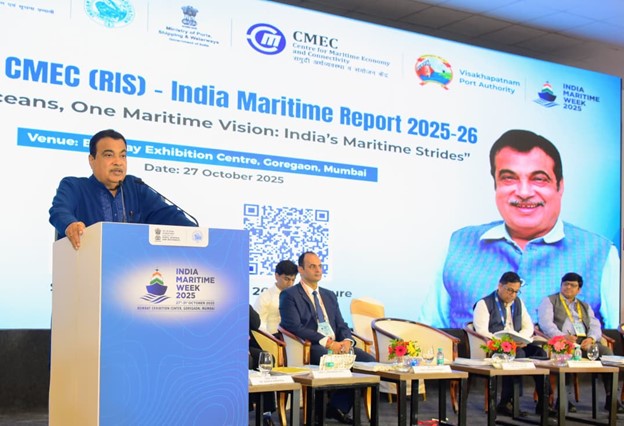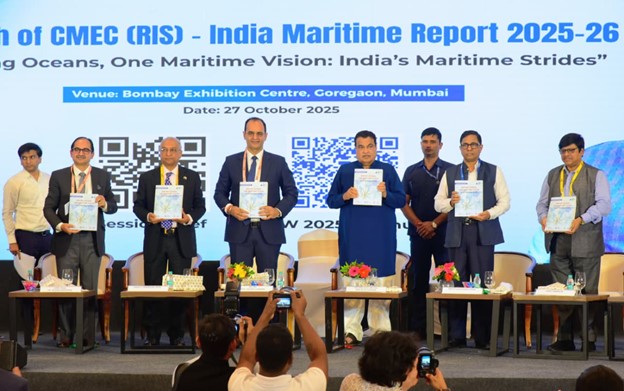Imagine standing on the Mumbai shoreline, watching massive cargo ships glide in and out of one of the busiest ports in the world. That is the heartbeat of India’s maritime world, a sector now valued at close to USD 1 trillion. Union Minister Nitin Gadkari brought this picture to life today while speaking at India Maritime Week 2025 in the city.

Fresh Funding Ideas for Ships and Ports
Gadkari focused on smart ways to fund shipbuilding and port projects. He explained how his road ministry managed to pull in ₹1.4 lakh crore from private players using models like Toll-Operate-Transfer, Infrastructure Investment Trusts, and public-private partnerships. Earlier, private firms handled just 10 percent of road work. Now that figure stands at 35 percent.
He believes the same tricks can work wonders for ports and shipping. Private companies bring fresh ideas, finish jobs faster, and deliver better quality. Most importantly, the government does not have to carry the entire money load alone. This frees up public funds for other urgent needs while projects move ahead smoothly.
A New Report Maps the Future
During the event, Gadkari released the CMEG (RIS) India Maritime Report 2025-26. The title says it all: “Uniting Oceans, One Maritime Vision: India’s Maritime Strides.” The document lays out clear steps to grow shipbuilding, repair yards, and recycling units across the country.

Sagarmala 2.0: The Big Push Forward
Gadkari praised Ports, Shipping and Waterways Minister Sarbananda Sonowal for driving Sagarmala 2.0. This upgraded plan follows Prime Minister Narendra Modi’s vision to make India a global maritime powerhouse. The goals are straightforward:
- Build more ships inside India instead of ordering from abroad.
- Upgrade repair and recycling facilities to world-class standards.
- Make ports faster and cheaper to use.
- Strengthen jobs and businesses along the coastline.
- Bring back life to rivers and canals for cargo movement.
When inland waterways pick up, trucks on highways will ease up. Fuel costs will drop. Pollution will fall. Villages near rivers will see new markets open up. It is a win all around.
Why Private Players Matter
Gadkari kept coming back to one point: private innovation changes everything. Give clear rules, honest processes, and strict timelines, and businesses jump in with both feet. They bring technology, management skills, and global networks that government teams alone cannot match.
Take the road sector example again. A decade ago, most highway contracts went to public firms. Delays were common. Costs kept climbing. Today, private builders finish stretches ahead of schedule. They maintain roads better because their payments depend on performance. The same logic applies to ships and ports.
Building Trust on the High Seas
India wants ship owners worldwide to feel confident parking their money here. That trust comes from predictable policies and quick decisions. Gadkari assured the audience that the government is committed to transparent tenders and time-bound approvals. No red tape, no endless file movements.
Coastal communities stand to gain the most. New ports mean steady jobs for local youth. Ship repair yards need welders, engineers, and logistics staff. Recycling units turn old vessels into steel without harming the environment. Every link in the chain creates work and wealth.
Numbers That Tell the Story
Let us break it down simply:
| Maritime sector value | ≈ USD 1 trillion (₹84 lakh crore) |
| Road ministry private funds | ₹1.4 lakh crore |
| Private share in roads (earlier) | 10% |
| Private share in roads (now) | 35% |
These figures show what focused funding models can achieve. Apply them to maritime, and the sky is the limit.
Looking Ahead
Events like India Maritime Week are more than talk shops. They bring bankers, shipbuilders, port operators, and policymakers to the same table. Deals get discussed. Partnerships form. Ideas turn into projects.
Gadkari ended on an upbeat note. With the right mix of public vision and private energy, India can lead the maritime world. Ships built on Indian soil will sail every ocean. Ports here will handle cargo faster than rivals. Coastal towns will thrive. And the blue economy will power national growth for decades.
Focused keyword: ship financing
Meta description: Ship financing innovations can transform India’s USD 1 trillion maritime sector. Nitin Gadkari reveals proven funding models at Mumbai summit to boost ports and shipping
